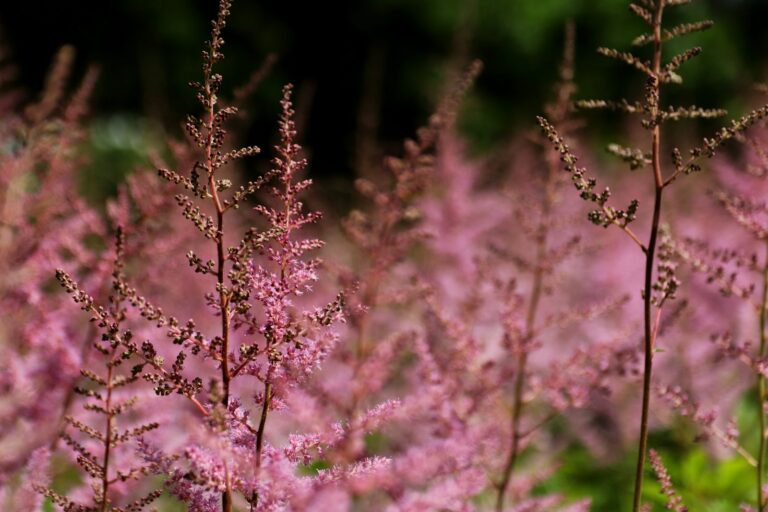Astilbe Stress Problems: Heat, Drought & Sun Damage Solutions
Your astilbe leaves curl upward and turn brown at the edges while thriving plants remain lush just feet away. The difference comes down to environmental stress levels reaching critical thresholds that trigger visible damage[1]. Understanding these stress responses transforms struggling plants into vigorous performers.
Understanding Astilbe’s Moisture Dependency
Astilbe is one of the most moisture-dependent perennials among shade gardens[2]. These species have evolved in woodland environments, where constant soil moisture and filtered light provide an ideal environment in which to thrive. When environmental triggers exceed their tolerance, astilbes exhibit recognizable stress responses requiring immediate intervention.
Astilbe foliage and growth habit reflect environmental stress in patterns of growth and different habits. Edges of leaves curl upward and turn brown or black when heat and drought stress occurs[1]. Whole leaves turn brown and dry out, while entire leaves appear shriveled-up, looking thin and ragged under stress. Plants subjected to excessive sun or insufficient water are most frequently at risk of this damage[1].
Recognizing Heat and Sun Damage
Heat stress causes wilting on hot days and scorched leaf edges[3]. Astilbe has delicate green leaves which are not able to withstand intense direct sunlight under moisture limitation. Hot afternoon sun can cause plants to wither, brown, and indeed die[4]. Moving plants to shadier areas or zones with morning-only light avoids such serious damage.
Similar browning patterns occur under drought stress, but the path is predictable. The sharp margins of leaves reveal urgent drought stress which requires rehydrating the root system immediately[5]. When soil conditions are hot and dry, plants can have small leaves and scorched foliage[6]. Sustained drought stress will kill plants if moisture levels do not improve[7].
Sun Scorch and Light Requirements
When astilbes have too much direct sunlight, they become sun scorched beyond their tolerance. Astilbe prefers part shade growth; however, it can survive well only if provided abundant moisture. Too many direct sun rays can burn delicate leaves and deprive soil of moisture. And in hot summer climates, astilbes will require shade in the afternoons even if they are planted in full sun[2].
The degree of success of astilbe depends on the light exposure and moisture requirements.
Plants are good growers in partial shade and they can flourish in full shade, but possibly with fewer blooms[8]. Maintaining full sun tolerance relies completely on the availability of moisture. Dry soils won’t be forgiving of moisture, because leaves will brown easily in them[8].
Moisture-Related Stress Symptoms
Stress due to moisture manifests in two different ways and causes a whole range of symptoms. Underwatering causes:
- Wilting leaves and stems that do not perk up immediately after watering
- Dry and brittle edges of leaves
- Stunted growth[10]
Overwatering results in symptoms that mirror underwatering and can mimic it—including wilting, but the soil will not be dry; instead, it will be wet[10].
It is important to distinguish between overwatering and underwatering for proper treatment. Astilbe can die if the soil does not drain properly[11]. Soil should be moist not soggy. Waterlogged and heavy clay soils not only reduce the vigor of plants but also decrease their ability to grow even when moisture levels seem adequate[8].
Transplant Shock and Diagnosis
Transplant shock explains leaf scorch in plants receiving proper care[12]. Though astilbes are sensitive to drought, transplant shock could explain observed leaf scorch[12]. While too much water can create the same impact as too little, diagnosis will present challenges without an adequate assessment of soil moisture.
Poor growing conditions, rather than pests or disease[13], are the main causes of browning astilbe. Astilbe thrives in moist soil with good drainage and partial shade[13]. It needs specific conditions to flourish:
- Proper sunlight exposure
- Well-drained soil
- Consistent moisture during establishment
- Appropriate pruning timing
Recovery from Environmental Stress
Accelerated recovery from environmental stress depends on how quickly and severely interventions are applied. Astilbes possess unparalleled regeneration capacity if properly protected after drought[14]. Plants trimmed to ground level, deeply watered, and mulched with fresh material tend to regenerate in weeks if crowns survive[14]. Recovery time ranges from two days to several months, depending on the extent of damage[15].
Plants neglected for too long can also take months to recover from heat stress during heatwaves[15]. In dire situations, it is difficult to restore stressed plants to life. Acting quickly when first symptoms appear provides the best chance for full recovery.
Prevention Through Proper Site Selection
Prevention strategies focus on plant placement appropriate to growing requirements. The soil must be fertile, moist, humus-rich soil that plants need to thrive[8]. Annual additions of compost or organic material around the plant base reward gardeners with abundant blooms and healthy foliage[16]. Incorporating peat moss, compost, or other organic matter into clay and poorly drained soils before planting significantly improves soil conditions[8].
Mulching supports the most fundamental defense against environmental damage. Addition of organic bark mulch each spring benefits astilbe greatly[2]. And because astilbe hates drying out, mulch also keeps the soil moist and adds organic matter to soil over time. Apply a layer of:
- Shredded leaves
- Evergreen needles
- Other organic mulch
Apply mulch to the soil surface to keep the roots cool and moist[7].
Watering Strategies for Success
It is the watering method that decides if astilbes thrive or just exist. Far from frequent shallow sprinkles, slow deep soaks that reach deep roots and help summer plants survive are preferred in astilbes to frequent shallow ones[17]. At the same time, for the plants to survive the heat of summer[18], one inch should be supplied carefully once per week[18]. To resist the natural inclination for shallow rooting, avoid watering a little each day, until root growth can take root deep.
Deep watering can encourage plants to push roots down deeper in the soil, thus decreasing watering requirements over time and holding the plants while weather changes from dry to dry[18]. When soil moisture is unsure, it is better to stick your finger or trowel 1 inch or more into the ground[18]. If soil moisture level is low, do a thorough watering so as not to lose this, which will keep plants alive through time.
Climate Zone Considerations
Lighting needs depend on climate zone and cultivar heritage. Most astilbe varieties will be able to withstand full day sun in cool northern climates[16]. In southern US regions, astilbes prefer a light to moderate shade with no more than 3 to 4 hours of sun a day[18]. The critical factor is stable moisture in spite of sun exposure[18].
| Climate Zone | Light Tolerance | Key Requirement |
|---|---|---|
| Cool Northern (Zones 3-5) | Full day sun acceptable | Consistent moisture |
| Moderate (Zones 5-7) | Morning sun, afternoon shade | Daily watering in heat |
| Hot Southern (Zones 7-9) | Light to moderate shade only | 3-4 hours sun maximum |
Chinese astilbe species are more tolerant of the sun and drought than all other types of astilbes[2]. Unlike most species of astilbe that need heavy shade, Chinese astilbe prefers partial shade, can stand more sun and drought-like conditions[19]. But these plants still should not be allowed to dry out[19], as leaf scorch still remains probable when soil moisture falls.
Soil Preparation and Amendments
A variety of environmental stress problems are avoided by pre-planting soil preparation. Adding organic material protects soil from drying[2]. In case of dry soil, foliage can curl and get scorched on hot summer days[2]. Compost or aged manure amendments on soil, especially on clay forms, enhance soil fertility as astilbe is a heavy feeder[16]. Perlite and coarse sand to improve drainage is done to ensure that the soil is not puddled[16].
Monitoring for Early Stress Signals
Observing plants for early stress signals can enable intervention before it is too late. Verify that the astilbes stay moist by looking beneath the soil, beneath the mulch, and not by how a few feet of mulch beneath layers looks like[20]. If there is no rain, water deeply and regularly as opposed to sprinkling frequently[16]. Be careful not to allow soil to dry out between watering times during establishment periods or hot weather[2].
Managing Existing Stress Damage
Different strategies may be needed to repair and manage the existing stress damage based on its magnitude. Keep watering astilbe regularly and avoid getting too much direct sunlight[13]. Apply mulch to maintain water in soil but no soggy soil should be given to water[13]. Water long after it’s been drought-rooted, even if some plants get browned. They may return in good condition next year. Keep watering[13].
For highly stressed plants with extensive browning, restore vegetation to ground level, depending on severity of damage[2]. Water well after the removal and perhaps plants will continue to grow and be suitable for the remainder of the year[2]. If there is stress early in the growing season, it is well received and the plants have the time to grow again before fall.
Timing Interventions for Best Results
Recovery is influenced by the timing of interventions. Leaves may also become yellow naturally after the first frost as part of the seasonal dormancy[16]. Trim them, as there is new growth in spring[16]. When cared for during the fall and winter, drought-stressed astilbes tend to return the next season[7]. Keep soil moist rather than waterlogged and put mulch down to protect crowns[7].
Spacing and Air Circulation
Air circulation and space vary a lot; these have an impact on stress susceptibility. Change plant shapes and control fungal and nematode infections through trimming or even moving your own plant[13]. Overgrown clumps favor division every 3 to 4 years in spring if they grow in clusters and divide up periodically during the spring[8]. Water and mulch well to aid establishment after division[8]. In addition to improving vigor and removing competition for moisture from the crowded root systems, it also reduces the competition for moisture.
Choosing Stress-Tolerant Cultivars
Familiarity with cultivar differences facilitates the alignment of plants to challenging sites. Cultivars with Chinese astilbe ancestry have better drought tolerance and can tolerate greater sunlight exposure than conventional cultivars[2]. When planting in less favorable environments, choose strains selected for increased stress tolerance, rather than assuming astilbes will perform equally.
Key Takeaways for Environmental Stress Management
Environmental stress in astilbe results from an imbalance between plant needs and production realities. Success is in offering constantly moist, well-drained soil in partial shade locations, protection from mulch, deep and consistent watering, and choosing plants for the specific climate zones you will be in. On the rare occasions where stress occurs, rapid intervention — watering, mulching and potentially reducing damaged plant growth — is likely to represent the best opportunity for recovery and long-term plant health.
Key Sources:
[1] Heat and Drought Stress | University of Minnesota Extension
[2] How to Grow Astilbe | American Meadows
[3] Japanese Astilbe Wilting: Causes and Solutions | Greg
[4] Care of Astilbe | Melinda Myers
[5] 12 Brilliant Astilbes | Fine Gardening
[6] Astilbe not well this year | Illinois Extension
[7] Astilbe Leaves Turning Brown | Melinda Myers
[8] Growing Astilbe in Iowa | Iowa State University Extension
[9] Astilbe | Gardenia.net
[10] Watering Potted Astilbe | Greenship Garden
[11] Watering Astilbe | Plant Addicts
[12] Astilbe Brown Leaves | Ask Extension
[13] Astilbe Is Turning Brown | Gardening Know How
[15] How long does it take a plant to recover from stress? | Monrovia
[16] How to Grow Astilbes | The Old Farmer’s Almanac
[17] Is the Seacoast Climate Changing Beyond Astilbe’s Comfort Zone? | Seacoast Gardener
[18] Plant & Care for Astilbe | White Flower Farm
[19] Perennial Solutions: Astilbe chinensis ‘Visions’ | GPN Magazine
[20] How to care for astilbe plants | Facebook Gardening Group
Lily Morgan is a home gardener. She grows houseplants and designs small-space gardens. She shares what she learns from experience. Lily offers simple, practical tips for plant lovers. Her goal is to help others garden with confidence. She wants to help them grow, one leaf at a time.


